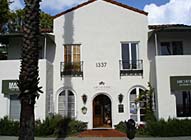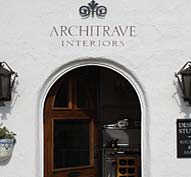




1337 Ocean Avenue


Spanish Colonial Revival-style
photo by Michael Grandcolas

Entrance detail
photo by Michael Grandcolas

Another view
photo by Michael Grandcolas

Earlier photo
Spanish Colonial revival is really a collection of styles, unified by the use of arches, courtyards, form as mass, plain wall surfaces, and tile roofs, all derived from the Mediterranean world. Designers were inspired by a number of sources: the adobe and colonial buildings of Monterey, California; late forms of Moorish architecture; medieval Spanish and Italian church architecture; Ultra-Baroque design of colonial Spain and Portugal; rural forms from Andalusia; Italian Romanesque and Renaissance revival elements; and southwest Hopi and Pueblo Indian adobes. This broad source base made it relatively easy to create a convincing harmony between the exterior image, interior space, decorative elements, and the building's function.
John Balsley and his wife Ella purchased the parcel that is now 1337 Ocean Avenue in 1911. In 1926, they constructed the four-unit apartment house and garage. This Spanish Colonial Revival-style building is noteworthy in that it was constructed during the City’s first major development boom as a mixed-use building with four apartment units and a ground floor commercial space. It was constructed during the era when Santa Monica transitioned to a year-round resort community. At the time, 1337 Ocean Ave. was at the edge of the City’s downtown, marking a transition area from the ocean view residential properties to the north.
Notice that the front of the building has three bays. The central and largest section is capped with a red tiled front-facing gabled roof. It contains an arched door flanked by lanterns and two large wood-framed, multi-paned French doors, one is ornamented with a wrought iron balconet. The theme is repeated on the second floor; the central bay has two French doors with balconets. The square-shaped side bays feature large fixed-paned windows at street level. On the second floor, French doors open onto semi-enclosed landings. The side bays have tiled shed roofs, while the remainder of the main body of the building has a flat roof and tiled parapet. On either side of the building are tile-capped wing walls with arched shaped openings leading to the side yards. The 50’ by 150’ property is located just west of the central business district. City permits were not found for the property and the architect is unknown. There is a similar looking property just south at 101 Santa Monica Boulevard. Nobody has applied for permits to alter that building, so it has yet to be landmarked.
The Balsleys owned the property until 1937. One ground floor tenant, the Universal Truth Library occupied the building until around 1938. Ownership of the subject property changed hands several times in the following years. The 1940 city directory listed the widow of the original property owner, Mrs. Ella Balsley as a tenant. It was under the next owners, Edwin and Hazel Berdine that the property got its formal name: the Casa Bonita Apartments. The property became a full commercial property in the 1970s.
Neighboring properties at 1333 Ocean Avenue and the Gussie Moran House,
are also Santa Monica Landmarks, creating a cluster of Landmark properties,
each with individual architectural significance, and which exemplify the
oceanfront downtown edge’s historical development pattern.